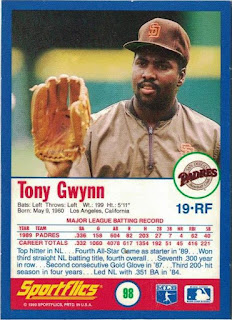Today's post features three cards from 1990 that are completely unrelated to each other. Just for fun, like.
Card Number 1003: Topps Batting Leaders, 1990; #2
These cards were inserted into blister packs of 100 cards from Topps flagship set that were exclusive to K-Mart.
The cartooney drawn baseball bat makes this look quaint, even considering it's from way back in 1990.
The politest way to describe the cardback is that it doesn't look like the designer made too much of an effort but did just enough to earn their paycheck.
Tony's final career batting average went
up from this point. In terms of hitting baseballs, he was an absolute monster in the decade after this card was released.
Card Number 1004: Sport's Collector Digest, 1990; #37
This isn't a baseball card, it's a pocket price guide! (Oh, okay, sure thing, Sport's Collector Digest.)
This is the second 'pocket price guide' to feature on this blog (
here's the other one). It's fair to say that if more price guides looked as good as the front of this card, more people would collect price guides!
These guides provide an insight into the expansion of the collecting bubble in the early 1990s. Comparing these prices to the valuations SCD put on cards in 1993, shows how much a collector could have made by investing in rookie cards in 1990.
SCD reckoned that mint Topps rookie cards had doubled in price from $20 in 1990 to $40 in 1993, while the five hundred per cent growth in value for a mint 1984 Fleer card (from $2 to $12) was a huge jump for a second year card.
All this is a casual reminder that card values are always inflated by the companies doing the valuations. The real value of a card is not what a company claims it to be - the real value is the price it actually sells for. This is true regardless of whether the price is listed on a magazine or on a nice baseball-card sized 'pocket price guide'.
Card Number 1005: Sportflics, 1990; #98
Sportflics are lenticular cards that show player in three different poses. I am not keen on them for a number of reasons. They don't scan well. They are thick plastic and the plastic yellows with age. And they warp because of the plastic coating.
But apart from that, they're OK.
Sporflics are reasonably important in the history of baseball cards because they were the entry product for the Pinnacle company who then produced Score cards before releasing sets under the Pinnacle brand name. The back of this card shares a lot of design aesthetics with contemporary Score cards, particularly the use of a colour photo, the lettering and presentation.
On top of all the other issues with Sportflics cards, I'm going to ding this a point for having Tony's squad number more obvious than the card set number, and ding it another point for having a set number that looks like a different number. It's not #88, it's #98! However, I will give it a point back for the quirky photo showing Tony with his glove half-on, half-off.
Total: 1005 cards



.jpg)
.jpg)





.jpg)



















.jpg)
.jpg)
.jpg)